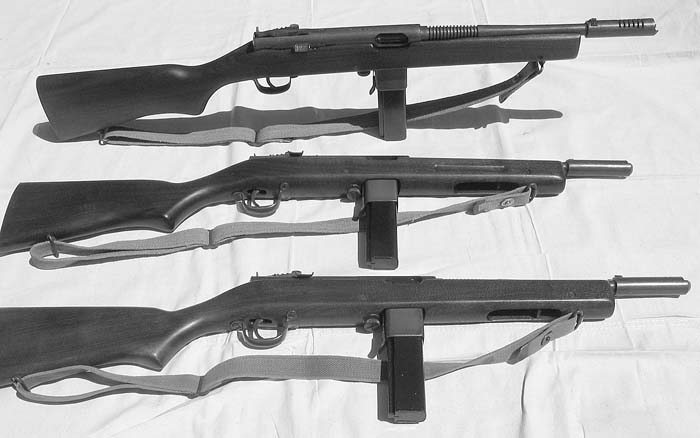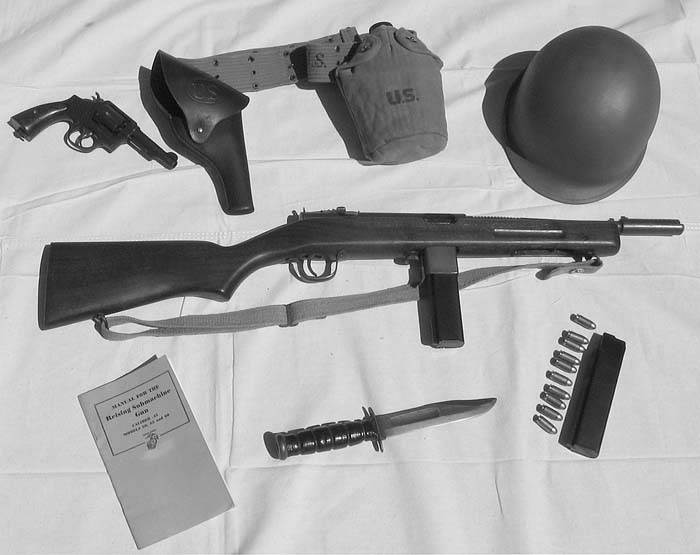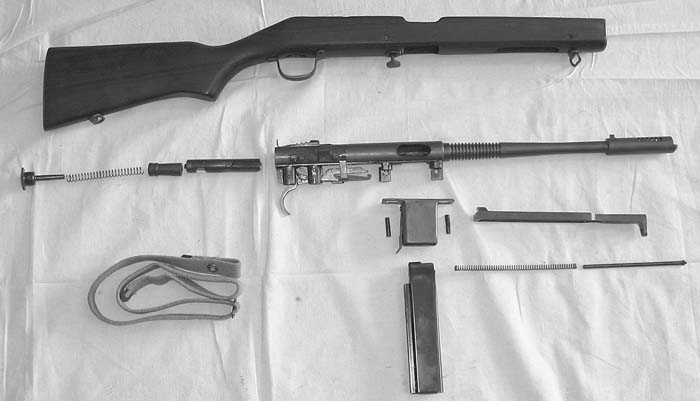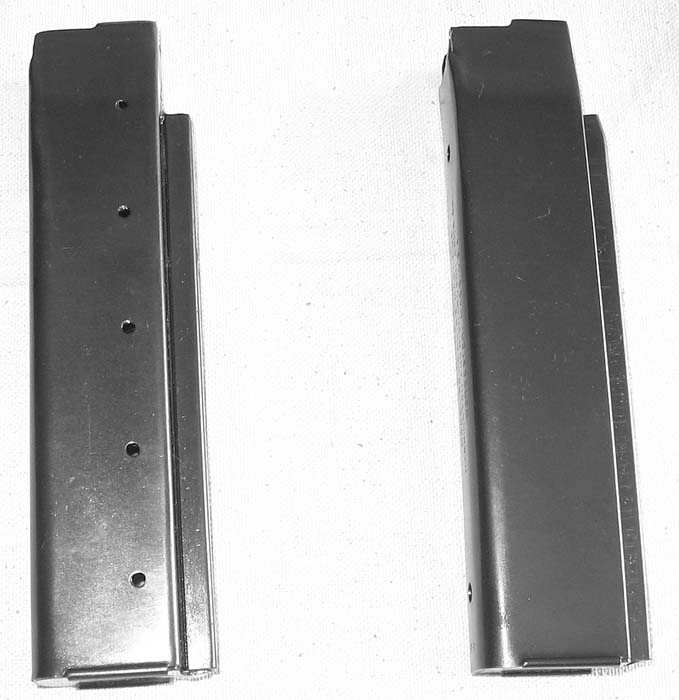By Robert C. Ankony, PhD
The US Navy and Marine Corps placed their first order for .45 caliber Reising submachine guns in January 1942, just one month after America’s entry into World War II. Produced throughout the war, Reisings saw service in both the Pacific and European theaters, with security personnel domestically, and with law enforcement and correctional agencies after the war.
The Reising was a most innovative weapon featuring accuracy, firepower, lightweight and ease of manufacturing. But poor combat performance and favorable law enforcement use forever mired the weapon in controversy. To properly assess the Model 50 and 55 Reising submachine guns, and the Model 60 semiautomatic rifle, we must begin with their inventor, Eugene G. Reising, and the circumstances of his time.

History
Eugene Reising was an excellent marksman and ordnance engineer who believed engineering principals must match actual field needs. Reising practiced his creed by being an avid shooter and by serving in the early 1900s as an assistant to the distinguished firearm inventor, John M. Browning. In doing so, Reising contributed to the final design of the US .45 Model 1911 Colt Automatic Pistol, one of the most reliable pistols in history. Reising then designed a number of commercial rifles and pistols on his own, when in 1938, he turned his attention to designing a submachine gun as threats of war rapidly grew in Europe.

Two years later he submitted his completed design to the Harrington and Richardson Arms Company (H&R) in Worcester, Massachusetts. It was accepted, and in March 1941, H&R started manufacturing the Model 50 full stocked submachine gun. Months later, production began on the Model 55 (identical to the Model 50 other than having a folding wire buttstock and no compensator); and the Model 60 full stocked semiautomatic rifle that also resembled a Model 50, but had a 7.75 inch longer barrel without cooling fins or compensator.
H&R promoted the submachine guns for police and military use, and the Model 60 for use by security guards. But events half a world away changed everything. The Japanese attacked Pearl Harbor in December 1941 and the US was suddenly in desperate need of thousands of modern automatic weapons. Since the Reising’s only competitor was the venerable .45 Thompson Model 1928A1 submachine gun, a weapon that epitomized reliability and exquisite machining, the more easily manufactured Reising was quickly adopted by the navy and marines as a limited-standard weapon.
The US Army first tested the Reising in November, 1941 at Fort Benning, Georgia, and found several parts failed due to poor construction. Once corrected, a second test was made in 1942 at Aberdeen Proving Grounds, Maryland. In that test 3,500 rounds were fired resulting in two malfunctions: one from the ammunition, the other from an incomplete bolt locking. Still, the army didn’t adopt the Reising, but the navy and marines did, faced with insufficient supply of Thompsons.
The navy and marines also viewed the Reising as having several advantages over the Thompson. It was less costly (approximately $62 versus $200), it was much lighter (about 7 versus 11 pounds), it was better balanced, more streamlined, and more accurate in semiautomatic fire. And, the Model 55 was more compact (about 22 versus 33 inches in length – the shortest, lightest and most powerful submachine gun in the world at the time).
The Reising cost and weighed less because it was made mostly of stampings and had a closed-bolt design that was much lighter than blowbacks of its kind that fired from an open-bolt position and relied on weight, rather than locking, to secure the cartridge at time of firing. It was more balanced because the barrel and receiver-group rested concentrically within the stock. It had smoother lines because the stock was of conventional shape and the cocking handle (action bar) was placed inside the forearm. And it was more accurate because the closed-bolt only shifted the hammer and firing pin on firing, whereas the Thompson slammed home a heavy bolt and actuator.
The Reising submachine gun first saw action on August 7, 1942, exactly eight months to the day after Pearl Harbor, when 11,000 men from the First Marine Division stormed the beaches of Guadalcanal, just south of the equator in the Solomon Islands. This sweltering ninety-mile long mountainous island was covered with dense jungle and swamps, and was defended by Japanese. Since Guadalcanal had an airfield, the island had to be taken as aircraft from there could isolate Australia and New Zealand from America.
To the marines’ surprise, as they stepped off their landing craft and their naval fire crept forward, they were met not by Japanese, but by silence and shattered coconut groves that fringed the beach. Advancing cautiously into the dark, musky jungle, they pushed on and took the airfield the following day. But Japanese warships and reinforcements were en route. That night, powerful shell fire swept the marines as they were suddenly cut off from sea; to be locked in mortal ground combat with the Japanese Thirty-fifth Infantry Brigade, and Second and Twenty-eighth Divisions.
On the same date of Guadalcanal’s invasion, the Model 50 and 55 saw action by fast striking, camouflage dressed, First Marine Raiders on the small outlying islands of Tulagi and Tanambogo to the north. Two companies of marine paratroopers “The Devil Dogs” dressed in olive drab jump smocks also used Model 55s to attack the island of Gavutu, between Tulagi and Tanambogo.
Although Tulagi and Tanambogo were each secured in a day, the fighting was fierce. Japanese firing from caves and beach dugouts destroyed many of the raider’s assault craft before touching shore. At day’s end, the raiders suffered 234 casualties from a 750 man force. The paratroopers fared worse. Of the 377 men who assaulted Gavutu, 212, or roughly two-thirds, were killed or seriously wounded, many because escorting warships couldn’t provide close fire in the uncharted waters, and bombers sent to assist the paratroopers, dropped their ordnance short killing their own men.
Following six months of intense fighting, Guadalcanal fell to the marines on February 7, 1943, at a cost of 6,000 wounded and killed Americans as well as 20,000 dead Japanese. Guadalcanal’s capture marked the beginning of the end of the Japanese Empire. For other than minor moves in Burma and China, the Japanese were continuously pushed back toward their homeland.
Moving ever northward, the Third Marine Division landed on Bougainville, November 1, 1943. Pitted against members of the Japanese Sixth Division, marine raiders made flanking attacks. In the book Flags of Our Fathers by James Bradley, a camouflage dressed, Sergeant Mike Strank, Third Marine Raiders, is shown holding a Model 55 on Bougainville. Sergeant Strank survived that battle to be known as a marine who gave his all to protect his men from the enemy. But in 1945, after helping to raise the American flag on Iwo Jima, he died on a rocky, windswept plain there; a victim not of the Japanese, but of American naval fire.
On the other side of the world, in Europe, Reising submachine guns saw service in early 1942 when a large contingent of US Marines relieved British troops on Iceland to prevent a German takeover. Two years later, June 4, 1944, the US Navy captured the U-505, a German sub with all hands on the North Atlantic, and wartime films show American sailors armed with Model 50s leading the captives down a gangway into Great Britain.
Issues of reliability
H&R was justifiably proud of the Reising. But the weapon’s close tolerance and delicate magazine proved unreliable in the mud and sand of the Solomons unless kept scrupulously clean. Quickly despised by front-line marines, Lieutenant Colonel Merritt A. Edson, Commander, First Marine Raiders, ordered that Reisings be flung into Guadalcanal’s crocodile infested Lunga River, as his troops resorted to reliable bolt-action Springfield rifles.
This failure made a mockery of H&R’s company slogan, “Six-and-one-half pounds of controlled dynamite. The H&R Reising will get a bullet there when you need it!”
There are other reasons for its failure. Foremost was the Reising’s complex design of many small pins, plungers, springs and levers. Disassembly and assembly was difficult even under normal conditions. Simple maintenance was problematic as there was no bolt hold-open device. Chambering a cartridge was awkward as the action bar was hard to grasp in the forearm and could be obstructed by the sling. Worse, the safety/selector switch couldn’t be sensed by feel at night if it was in the safe, semi, or automatic position.

“Filing-to-fit” of certain parts during production limited interchangeability. The exposed rear sight had no protective ears and was vulnerable to breakage. The adjustable front sight could be lost if the retaining screw wasn’t tightly secured. The weapon was susceptible to jamming if grime clogged the bolt’s locking recess in the receiver. The magazine guide retaining pins and receiver stud holes were tapered allowing disassembly and assembly only from one direction; right to left for disassembly, and left to right for assembly: a tough thing to remember in combat. And, if the retaining pins were inserted too much or too little, the receiver might not fit back into the tight confines of the stock.
In spite of these shortcomings, the serviceability of the Reising must be questioned if elite marine raiders, as witnessed by Sergeant Strank, were still using the weapon in November 1943; fully one year after the invasion of Guadalcanal when M1 Rifles, Carbines, and M1 Thompsons were by then available. Indeed, Reisings were issued to sailors and rear echelon marines throughout the war, and to Navaho code talkers who assisted front-line marines by giving instant radio communications in native tongue.
Thousands more Reisings were purchased by the US Coast Guard or sent to our British, Canadian, and Soviet allies under our Lend-Lease plan. And hundreds (mostly Model 60s) were allotted to security details at manufacturing plants, power stations, supply depots and bridges throughout the US.
Model Confusion
What constitutes a “commercial” and “military” Model 50? It should be noted that H&R never made a distinction; the distinction is made by collectors. This confusion stems from a period in production where early Model 50s were manufactured with commercial characteristics and H&R’s wartime practice of randomly installing old parts in stock throughout production.
While there’s not one factor that distinguishes the so-called commercial from the military model, the commercial model is usually blued. It commonly has a fixed front sight and a rear sight with no retaining screw. It often has 28 fins on the barrel, a one piece magazine release, no outward flanges on the safety/selector switch, and no sling swivels. Lastly, the commercial model commonly has a smooth take-down screw, a two-hole trigger guard, and serial numbers ranging from one to 20,000.
Military Reisings are usually parkerized. They often have an adjustable front sight with an Allen screw and a rear sight with a retaining screw. They routinely have 14 fins on the barrel, a two piece magazine release, outward flanges on the safety/selector switch, sling swivels, stock ties (crossbolts through the forearm), and a knurled take-down screw. Finally, the military model commonly has a three-hole trigger guard, proof-marks like “PH” or “Pm2” above the chamber, and serial numbers ranging from 20,000 to 120,000.
There are three types of H&R magazines. The first and second models both have a smooth body, are blued, and are twenty-shot double column. The first model is distinguished by five cartridge peep holes on the left side, a feature eliminated on the second model to prevent mud and sand from entering. In contrast, the third model is parkerized, has two long indentations on the sides, and because of feeding problems experienced with former models, is a twelve-shot single column magazine.
Production
Production of the Model 50 and 55 submachine guns ceased in 1945 at the end of World War II. Nearly 120,000 submachine guns were made of which two thirds went to the marines. H&R continued production of the Model 60 semiautomatic rifle in hopes of domestic sales, but with little demand, production stopped in 1949 with over 3,000 manufactured.
H&R sold their remaining inventory of submachine guns after the war to police and correctional agencies across America who were interested in the Reising’s selective-fire capability, great accuracy and low cost relative to a Thompson. Faced with continued demand, however, production resumed in 1950 and then sputtered to a halt in 1957 with nearly 5,500 additional Model 50s manufactured. But just when the Reising story seemed to end, a foreign order was received in the 1960s for nearly 2,000 more Model 60s, but that order was finally the end.

Decades later, in 1986, H&R closed their doors and the Numrich Arms Corporation (The Gun Parts) purchased their entire stock. Acquiring a number of Model 50 receivers, Numrich assembled them with parts. These weapons all have an “S” preceding the serial number and were sold domestically in the early 1990s after reparkerization and mounting on newly manufactured walnut stocks. These stocks are distinguished by their wider than normal sling swivels and buttstocks, by the fact they have no stock ties, and have H&R marked plastic buttplates (originals were unmarked metal).
Current Value
As with all machine guns, Reisings have skyrocketed in value; especially weapons designated as Curio and Relics (C&R) as Reisings are by ATF. This designation makes Reisings marketable not just to licensed machine gun dealers, but to C&R licensees and to private citizens in many states.
A little more than a decade ago a Model 50 in very good condition could be had for a few hundred dollars. Today, the same weapon would fetch $4,000, a Model 55 in similar condition $5,000, and a Model 60, $1,500. Consistent to the spiraling cost, an original H&R twenty-shot magazine costs over a hundred dollars and a twelve-shot magazine about eighty.
Summary
Reisings are mired in controversy. Their shortcomings are many but so are their positive features. Acclaimed as one of the most accurate and lightest submachine guns in their day, they faithfully served thousands of law enforcement officers for over a half century. A weapon with rich walnut stocks, a number of machined parts, and a unique history, they’ll provide fun for any shooter and prove a superb investment for any collector.
| This article first appeared in Small Arms Review V11N10 (July 2008) |











